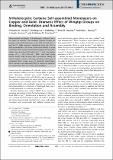N-heterocyclic carbene self-assembled monolayers on copper and gold : dramatic effect of wingtip groups on binding, orientation and assembly
Abstract
Self‐assembled monolayers of N‐heterocyclic carbenes (NHCs) on copper are reported. The monolayer structure is highly dependent on the N,N‐substituents on the NHC. On both Cu(111) and Au(111), bulky isopropyl substituents force the NHC to bind perpendicular to the metal surface while methyl‐ or ethyl‐substituted NHCs lie flat. Temperature‐programmed desorption studies show that the NHC binds to Cu(111) with a desorption energy of Edes=152±10 kJ mol−1. NHCs that bind upright desorb cleanly, while flat‐lying NHCs decompose leaving adsorbed organic residues. Scanning tunneling microscopy of methylated NHCs reveals arrays of covalently linked dimers which transform into adsorbed (NHC)2Cu species by extraction of a copper atom from the surface after annealing.
Citation
Larrea , C R , Baddeley , C J , Narouz , M R , Mosey , N J , Horton , J H & Crudden , C M 2017 , ' N -heterocyclic carbene self-assembled monolayers on copper and gold : dramatic effect of wingtip groups on binding, orientation and assembly ' , ChemPhysChem , vol. 18 , no. 24 , pp. 3536–3539 . https://doi.org/10.1002/cphc.201701045
Publication
ChemPhysChem
Status
Peer reviewed
ISSN
1439-4235Type
Journal article
Description
Funding: EPSRC PhD studentship (EP/M506631/1).Collections
Items in the St Andrews Research Repository are protected by copyright, with all rights reserved, unless otherwise indicated.

